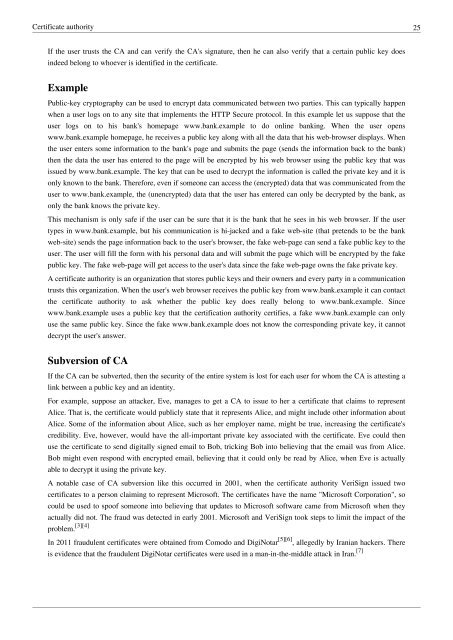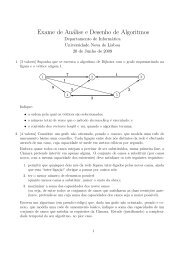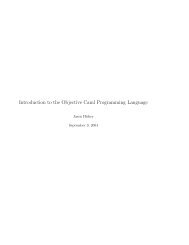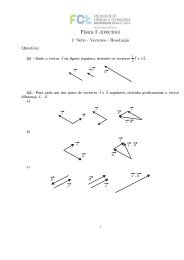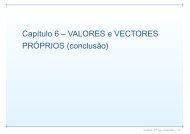Security Articles from Wikipedia
Security Articles from Wikipedia
Security Articles from Wikipedia
Create successful ePaper yourself
Turn your PDF publications into a flip-book with our unique Google optimized e-Paper software.
Certificate authority 25<br />
If the user trusts the CA and can verify the CA's signature, then he can also verify that a certain public key does<br />
indeed belong to whoever is identified in the certificate.<br />
Example<br />
Public-key cryptography can be used to encrypt data communicated between two parties. This can typically happen<br />
when a user logs on to any site that implements the HTTP Secure protocol. In this example let us suppose that the<br />
user logs on to his bank's homepage www.bank.example to do online banking. When the user opens<br />
www.bank.example homepage, he receives a public key along with all the data that his web-browser displays. When<br />
the user enters some information to the bank's page and submits the page (sends the information back to the bank)<br />
then the data the user has entered to the page will be encrypted by his web browser using the public key that was<br />
issued by www.bank.example. The key that can be used to decrypt the information is called the private key and it is<br />
only known to the bank. Therefore, even if someone can access the (encrypted) data that was communicated <strong>from</strong> the<br />
user to www.bank.example, the (unencrypted) data that the user has entered can only be decrypted by the bank, as<br />
only the bank knows the private key.<br />
This mechanism is only safe if the user can be sure that it is the bank that he sees in his web browser. If the user<br />
types in www.bank.example, but his communication is hi-jacked and a fake web-site (that pretends to be the bank<br />
web-site) sends the page information back to the user's browser, the fake web-page can send a fake public key to the<br />
user. The user will fill the form with his personal data and will submit the page which will be encrypted by the fake<br />
public key. The fake web-page will get access to the user's data since the fake web-page owns the fake private key.<br />
A certificate authority is an organization that stores public keys and their owners and every party in a communication<br />
trusts this organization. When the user's web browser receives the public key <strong>from</strong> www.bank.example it can contact<br />
the certificate authority to ask whether the public key does really belong to www.bank.example. Since<br />
www.bank.example uses a public key that the certification authority certifies, a fake www.bank.example can only<br />
use the same public key. Since the fake www.bank.example does not know the corresponding private key, it cannot<br />
decrypt the user's answer.<br />
Subversion of CA<br />
If the CA can be subverted, then the security of the entire system is lost for each user for whom the CA is attesting a<br />
link between a public key and an identity.<br />
For example, suppose an attacker, Eve, manages to get a CA to issue to her a certificate that claims to represent<br />
Alice. That is, the certificate would publicly state that it represents Alice, and might include other information about<br />
Alice. Some of the information about Alice, such as her employer name, might be true, increasing the certificate's<br />
credibility. Eve, however, would have the all-important private key associated with the certificate. Eve could then<br />
use the certificate to send digitally signed email to Bob, tricking Bob into believing that the email was <strong>from</strong> Alice.<br />
Bob might even respond with encrypted email, believing that it could only be read by Alice, when Eve is actually<br />
able to decrypt it using the private key.<br />
A notable case of CA subversion like this occurred in 2001, when the certificate authority VeriSign issued two<br />
certificates to a person claiming to represent Microsoft. The certificates have the name "Microsoft Corporation", so<br />
could be used to spoof someone into believing that updates to Microsoft software came <strong>from</strong> Microsoft when they<br />
actually did not. The fraud was detected in early 2001. Microsoft and VeriSign took steps to limit the impact of the<br />
problem. [3][4]<br />
In 2011 fraudulent certificates were obtained <strong>from</strong> Comodo and DigiNotar [5][6] , allegedly by Iranian hackers. There<br />
is evidence that the fraudulent DigiNotar certificates were used in a man-in-the-middle attack in Iran. [7]


